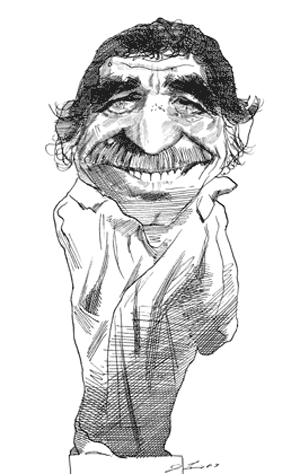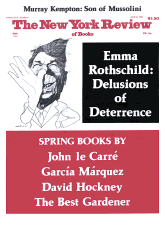The reputation of Gabriel García Márquez, which brought him the Nobel prize in 1982, stems very largely from the immense, seriocomic phantasmagoria of One Hundred Years of Solitude. Since that epic fantasy was published in 1970, Señor García Márquez has continued to ply his trade, bringing forth two shorter works of fiction (The Autumn of the Patriarch and In Evil Hour) as well as three collections of short stories. None, however, has come close to making the same sort of impression as the original novel; and quite a few of the short stories are frankly published as pulled from the writer’s files—they are works of as much as thirty years ago. Chronicle of a Death Foretold is a small book, hardly more than a novella (as Henry James would call it), but in no sense is it minor work. Without rehashing materials used before, it harks back again and again to the grand ironies and sinuous fantasy of the big novel, adapting them to a narrow scene and limited time scale. It feels, to a remarkable degree, heavy and strong.
The Chronicle deals with a single, simple, inevitable action in a Colombian riverside town of utter squalor. The time is about a quarter century ago, but the formal action is compressed into less than eight hours. The events of that brief time are retrospectively reconstructed in the novel by a journalist who was a young man in the town, and who now returns to interview the actors and to reassemble his disjointed memories. About the murder that is the central act of the narrative there is no mystery, nor any suspense. Everyone in the little town, with the possible exception of the victim, knows it is going to happen, and when, and where. Most even know why, or think they do, though perhaps the reader will be less sure of this matter at the end of the story than he was at the beginning. For in fact, though the action itself is plain, raw, and open, an element of doubt surrounds not only its origins but its consequences, a haze that thickens as the reporter traces and retraces the events of that distant morning.
At the root of the action is the marriage of Bayardo San Román with Angela Vicario. On the wedding night the groom (a relative stranger in town) discovers his bride is not a virgin; he instantly returns her to her family, and she, amid cuffs, slaps, and tears, confesses that her lover was Santiago Nasar. As family honor requires, her elder brothers Pedro and Pablo set out to murder Santiago. There is reason to hesitate, for he is very rich and they are humble pig butchers; besides, they have been celebrating the wedding, and are very drunk as well as exhausted from lack of sleep. It seems they do not much want to kill Santiago, for they tell practically everyone they see that that is what they are going to do. Still, nobody effectually stops them; and in a final scene of appalling messiness they cut their victim to pieces.
In many ways, the code governing this action is unambiguous, almost mechanical. Bayardo never questions for an instant what he must do when he finds that Angela is not intact; neither does she doubt that what he does is right. The two brothers feel neither shame nor remorse over their bloody reprisal; quite the contrary. Their deed was homicide in legitimate defense of honor, and they say frankly they would commit it a thousand times over, if necessary. A jury agrees with them; they are absolved. Society supports them all the way. Pablo Vicario had been engaged to Prudencia Cotes; they are ultimately married. But she says flatly she would never have married him if he had not done what a man should do—that is, kill Santiago. The brothers, though clearly rather hard-bitten fellows, are not truly criminal types; they had never been in trouble before, and while in prison awaiting trial are generally recognized as docile and even congenial prisoners.
The victim, while it is not absolutely certain that he did what Angela said (nobody ever saw them together or detected the slightest sign of mutual affection; rather, he usually spoke of her with casual contempt), was certainly capable of that and worse. Santiago Nasar was young, rich, handsome, and loose-handed where women were concerned; he was conspicuous, he was envied. Even his friends, who afterward thought they should have warned him, could hardly explain in retrospect why they had not. As if the entire town were going through a predetermined ritual that could not be interrupted, nobody said a word to warn the victim, though he could easily have protected himself or summoned protection from others.
The townspeople, then, acquiesce in the murder, some tacitly, others explicitly; so far as there is sympathy for any of the main characters, it goes to Bayardo, the disappointed groom; but since he soon leaves town (carried away by his mother and sisters, dead drunk), while Angela is sent off to bury her disgrace in a strange city, little that is tangible remains in the small town to keep the story alive. Yet live it does, festering and rankling in the minds of everyone aware of it, so that when the reporter comes back to investigate and analyze it, he finds that people remember practically nothing else—have, in fact, been worrying about this one dramatic incident for a full quarter century. Why they should do so, and what they have to worry about, it is of course the art of García Márquez to suggest. He ruminates and speculates, he reconstructs and recapitulates, giving in the process depth and vitality to a group of people who seemed at first glance flat and almost stereotypical. A “death foretold” indeed; the knifework was so widely anticipated and so completely scribbled over by the busy minds of the villagers that when, at the end of the book, it is enacted before us, we are surprised as well as appalled by the power it retains to shock us.
Advertisement
The murder is a dramatic center; but the minds weaving the pattern that ultimately involved and entangled the entire community remain half shrouded, a matter for extended rumination by the reader. From A Hundred Years of Solitude one recognizes here a curious mixture of jungle ferocity with a continental urbanity, even foppishness, of manner. Some characters from the early book are actually mentioned in the later one. But here the preternatural facts of the Buendia clan, their gift for carrying everything to an extreme and suspending the laws of nature in the process, are subdued to a dry comic irony. “My sister the nun who wasn’t going to wait for the bishop because she had an eighty-proof hangover” lifts one corner of the carpet to give the reader a glimpse underneath. The distinguished family of Plácida Linero was once renowned for the fact that “it had bred more than two barroom killers”; at present it seems to be in decline. And who can fail to be impressed by Pedro Vicario’s case of “sergeant’s blennorrhea,” which the victim “wears like a war medal”? In acrid, unemphatic phrases like these, the author creates both an intimate society and a long perspective on it.
Another peculiarity of the Chronicle is the combination of detailed factual particularity, usually on irrelevant points, with vagueness, confusion, or indifference on matters of more importance. The narrator is both omniscient when it suits him to be, and limited to the long-range investigation of memoirs and documents. There are times when he knows, and lets us know that he knows something, and just won’t tell. He traces minute by minute and step by step the movements of the villagers on that fatal Monday morning, often describing the same scene over and over in following the different characters taking part in it.
Yet on one crucial point after another, the evidence fails. Cristo Bedoya could have helped, but unaccountably didn’t; Colonel Lázaro Aponte and Indalecio Pardo inexplicably let crucial moments slip. Santiago Nasar himself showed no uneasiness whatever, no misgivings, though he knew the code of the society: was this innocence or was it arrogance based on the assumption that the Vicario brothers would not dare to kill anyone as rich as he was? The question comes up again and again: was the victim guilty? Even a direct question to the one person in a position to know yields no final answer. Angela Vicario is asked if she knew Santiago Nasar and she says, with wonderful eloquence, “He was my perpetrator.” But no sooner has she said this than the old question renews itself; didn’t she name Santiago only to shield someone else?
Thus the investigation of an ancient murder takes on the quality of a hallucinatory exploration, a deep groping search into the gathering darkness of human intentions for a truth that continually slithers away. There is a surprise double twist to the story, which it would be unfair for a reviewer to reveal; but the twist is itself an even deeper enigma, which the narrator, though he unquestionably knows more than he tells, cuts off with a cryptic act of silence.
Solitude is the basic condition of García Márquez’s characters in García Márquez’s world, and nowhere is it more pervasive than in this small unnamed village where everybody knows everybody else, and most people are related to one another. The bishop comes to visit the town, but never bothers to get off the boat or even allow it to dock; he just waves to the crowd on shore, blesses them mechanically, and goes his way. The brothers Vicario, having been absolved, fade into the background; Pablo marries and sinks into drudgery and anonymity; Pedro reenlists and vanishes into the jungle singing a whorehouse song. A report is written by an investigator, but though it fills 500 pages, it yields no information on any matter of interest or difficulty, and regularly lapses into gloomy aphorisms. The narrator of the novel consults its scattered and water-soaked pages (it has apparently never been filed), but finds in them only reflections of his own futility.
Advertisement
All of this is compressed into 120 pages; for all its sense of search, retrieval, repetition, and loss, the Chronicle of a Death Foretold indulges in no waste motion. It is tough-minded and keenly crafted. Though the book can be read in a few hours, its reverberations are unlikely to die away in the mind of an attentive and thoughtful reader for as many months. Indeed, when one reflects on how many “big” novels are really small after all, the notion may occur that we really need a new definition of “dimension” in fiction, based on something a little more significant than a count of words.
This Issue
April 14, 1983




